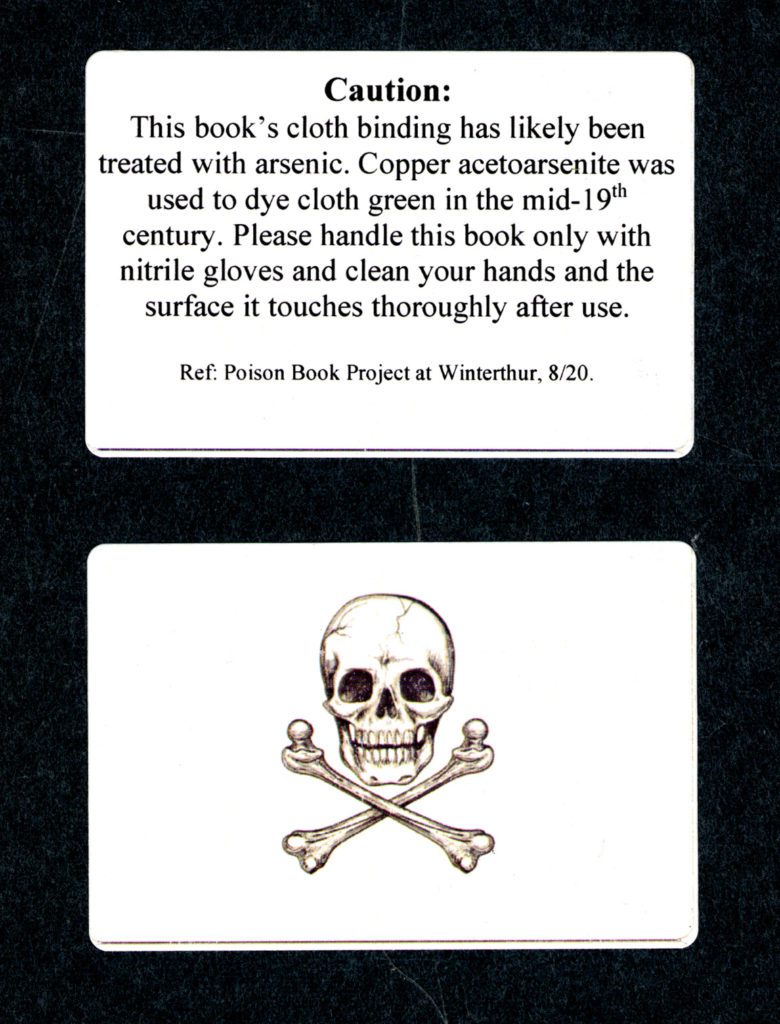

The green cloth cover of the volume, “Leaflets of Memory.”
from the VAULT
Beware the green binding. And mind the skull and crossbones.
By Cindy Landrum
A book bound with arsenic-laced cloth belongs in a murder mystery. But as one student revealed, it can also be found in Furman’s collections.

The labels on the box that now houses the book.
While doing online research for his Furman University Libraries internship last summer, Henry Dambach ’22 discovered that five books were on the list of “poison books,” compiled by the Winterthur Library in Winterthur, Delaware. The Winterthur list contains Victorian-era titles with emerald green book cloth colored by copper acetoarsenite, a toxic arsenical pigment.
Jeff Makala, Furman’s special collections librarian and university archivist, had sent the list to Dambach and suggested he check it against the library catalog to see if there were any matches.
“It surprised me,” Dambach says. “I knew they had used (arsenic) at that time, but I thought all those books had been destroyed and it wasn’t a problem anymore. I didn’t think we’d have any in our collection.”
In the Victorian era, pigment laced with arsenic was used in wallpaper, clothing and paint. Later, farmers used it as a pesticide, according to Jakob Povl Holck, a research librarian, and Kaare Lund Rasmussen, an associate professor in physics, chemistry and pharmacy, both at the University of Southern Denmark.
Four of Furman’s books were rebound or had a different-colored cloth, says Makala, who physically examined each of the potential “poison books.”
But the fifth book, “Leaflets of Memory,” was emerald green. “There’s a strong likelihood it has a poisonous binding,” he says. “Leaflets of Memory” is a literary annual that was published in 1855. It contains short stories, verses and sonnets.
Ironically, buyers usually purchased the book as a gift for someone special, such as their betrothed or a niece, Makala says. “It was a respectable, middle-class Christmas gift book.”

Henry Dambach ’22
“Leaflets of Memory” is part of Furman Libraries’ Special Collection and was not in general circulation. After the discovery, “Leaflets of Memory” was given a warning label with a skull and crossbones. The label outlines special handling instructions that include wearing nitrile gloves and cleaning hands and surfaces thoroughly after use.
The Winterthur Poison Book Project started in April 2019 after Melissa Tedone, lab head for book and library materials conservation at the Winterthur Museum, Garden and Library, began working on a book requested for an exhibition. According to an article in News and Conservation magazine, Tedone was surprised when the bright green colorant from the book flaked with the gentlest touch of her porcupine quill. She wondered if publishers used the same pigment found in Victorian wallpaper in book cloth.
After Winterthur’s lab confirmed Tedone’s fears, the investigation into potentially toxic book cloth began. Working with The Library Company of Philadelphia, they identified 28 volumes with bindings that tested positive for arsenic.
Winterthur’s investigation is continuing and will include chromium-based pigments, which are less toxic, according to the article. Makala says the odds are that Furman’s collection probably includes additional poison books.
“The big takeaway from this,” he says, “is that you can always learn new things from old books.”


